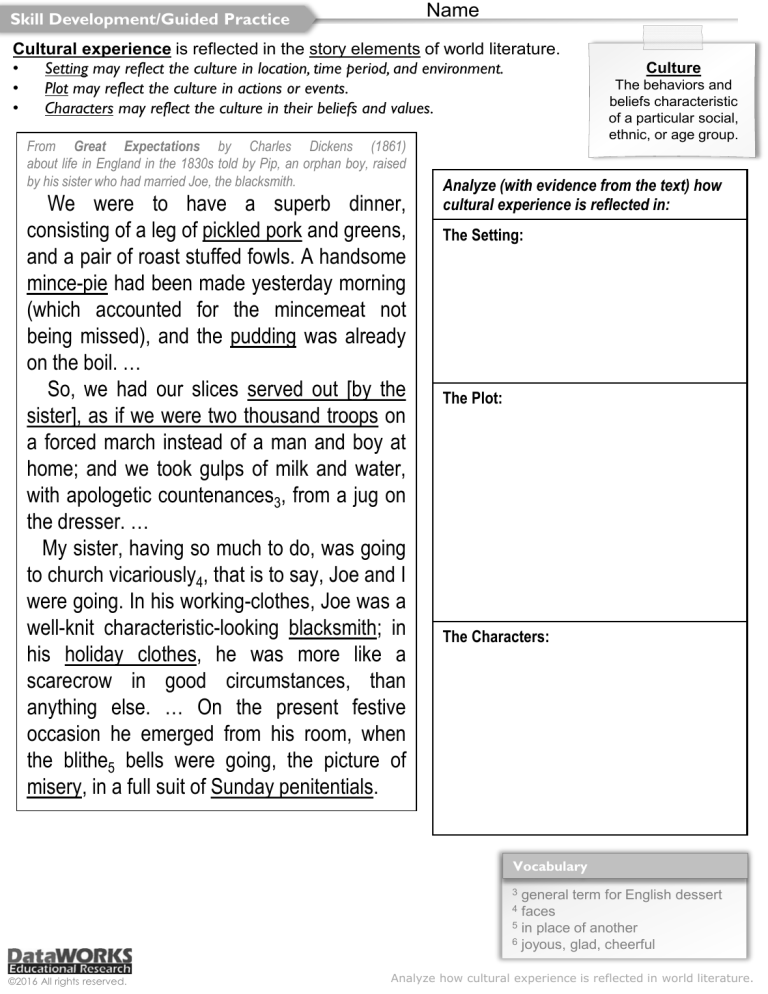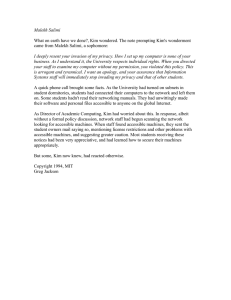
Name
Skill Development/Guided Practice
Cultural experience is reflected in the story elements of world literature.
•
Setting may reflect the culture in location, time period, and environment.
•
Plot may reflect the culture in actions or events.
•
Characters may reflect the culture in their beliefs and values.
From Great Expectations by Charles Dickens (1861)
about life in England in the 1830s told by Pip, an orphan boy, raised
by his sister who had married Joe, the blacksmith.
We were to have a superb dinner,
consisting of a leg of pickled pork and greens,
and a pair of roast stuffed fowls. A handsome
mince-pie had been made yesterday morning
(which accounted for the mincemeat not
being missed), and the pudding was already
on the boil. …
So, we had our slices served out [by the
sister], as if we were two thousand troops on
a forced march instead of a man and boy at
home; and we took gulps of milk and water,
with apologetic countenances3, from a jug on
the dresser. …
My sister, having so much to do, was going
to church vicariously4, that is to say, Joe and I
were going. In his working-clothes, Joe was a
well-knit characteristic-looking blacksmith; in
his holiday clothes, he was more like a
scarecrow in good circumstances, than
anything else. … On the present festive
occasion he emerged from his room, when
the blithe5 bells were going, the picture of
misery, in a full suit of Sunday penitentials.
Culture
The behaviors and
beliefs characteristic
of a particular social,
ethnic, or age group.
Analyze (with evidence from the text) how
cultural experience is reflected in:
The Setting:
The Plot:
The Characters:
Vocabulary
3
general term for English dessert
faces
5 in place of another
6 joyous, glad, cheerful
4
©2016 All rights reserved.
Analyze how cultural experience is reflected in world literature.
Skill Development/Guided Practice (continued)
Culture
The behaviors and
beliefs characteristic
of a particular social,
ethnic, or age group.
From War and Peace by Fyodor Dostoevsky
about high society life in St. Petersburg, Russia, in 1805.
(1869)
It was in July, 1805, and the speaker was the
well-known Anna Pavlovna Scherer, maid of honor
and favorite of the Empress Marya Fedorovna. With
these words she greeted Prince Vasili Kuragin, a
man of high rank and importance, who was the first
to arrive at her reception. Anna Pavlovna had had a
cough for some days. She was, as she said,
suffering from la grippe; grippe being then a new
word in St. Petersburg, used only by the elite.
All her invitations without exception, written in
French, and delivered by a scarlet-liveried8 footman
that morning, … [Prince] had just entered, wearing
an embroidered court uniform, knee breeches, and
shoes, and had stars on his breast and a serene
expression on his flat face. He spoke in that refined
French in which our grandfathers not only spoke but
thought, and with the gentle, patronizing intonation
natural to a man of importance who had grown old
in society and at court. He went up to Anna
Pavlovna, kissed her hand, presenting to her his
bald, scented, and shining head, and complacently
seated himself on the sofa.
Analyze (with evidence from the text) how
cultural experience is reflected in:
The Setting:
The Plot:
The Characters:
CFU
1 How
2 How
3 How
4 How
5 How
Vocabulary
did
did
did
did
did
I/you
I/you
I/you
I/you
I/you
determine what the question or prompt is asking?
determine the ELA concept required?
determine the relevant information?
answer the question?
determine if all parts of the question have been answered?
©2016 All rights reserved.
7
At this time, the Russian rulers
cultured ties with the West,
especially France, and expected all
nobles to learn and use French
8 uniform worn by a servant
Analyze how cultural experience is reflected in world literature.
Independent Practice
Name
Cultural experience is reflected in the story elements of world literature.
•
Setting may reflect the culture in location, time period, and environment.
•
Plot may reflect the culture in actions or events.
•
Characters may reflect the culture in their beliefs and values.
From A Passage to India by E. M. Forster (1924) about life in India when the
British ruled the country (1858-1947). It focuses on the differences between
East and West cultures, and whether there is something universal they share.
He had always liked this mosque. It was gracious, and
the arrangement pleased him. The courtyard— entered
through a ruined gate— contained an ablution1 tank of
fresh clear water which was always in motion, being
indeed part of a conduit that supplied the city. The
courtyard was paved with broken slabs. The covered part
of the mosque was deeper than is usual; its effect was
that of an English parish church whose side has been
taken out. Where he sat, he looked into three arcades
whose darkness was illuminated by a small hanging lamp
and by the moon. The front—in full moonlight—had the
appearance of marble, and the ninety-nine names of God
on the frieze2 stood out black, as the frieze stood out
white against the sky. The contest between this dualism
and the contention of shadows within pleased Aziz, and
he tried to symbolize the whole into some truth of religion
or love. A mosque by winning his approval let loose his
imagination. The temple of another creed, Hindu,
Christian, or Greek, would have bored him and failed to
awaken his sense of beauty. Here was Islam, his own
country, more than a Faith, more than a battle-cry, more,
much more . . . Islam, an attitude towards life both
exquisite and durable, where his body and his thoughts
found their home.
He repeated the phrase [a Persian verse he wanted
on his grave] with tears in his eyes, and as he did so one
of the pillars of the mosque seemed to quiver. It swayed
in the gloom and detached itself. Belief in ghosts ran in
his blood, but he sat firm. Another pillar moved, a third,
and then an Englishwoman stepped out into the
moonlight.
Analyze (with evidence from the text)
how cultural experience is reflected in:
The Setting:
The Plot:
The Characters:
Vocabulary
1
2
©2016 All rights reserved.
Culture
The behaviors and
beliefs characteristic
of a particular social,
ethnic, or age group.
a washing place
a decorative band at the top of a
wall
Analyze how cultural experience is reflected in world literature.
Independent Practice (continued)
Culture
The behaviors and
beliefs characteristic
of a particular social,
ethnic, or age group.
From Kim by Rudyard Kipling (1901) about a white orphan boy in India who gets
involved in spiritual and political activities.
There was some justification for Kim … since the English held the
Punjab and Kim was English. Though he was burned black as any
native; though he spoke the vernacular3 by preference, and his
mother-tongue in a clipped uncertain sing-song; though he
consorted on terms of perfect equality with the small boys of the
bazar; Kim was white—a poor white of the very poorest. … The
wife [his mother] died of cholera in Ferozepore, and O'Hara [his
father] fell to drink and loafing up and down the line with the keeneyed three-year-old baby. Societies and chaplains, anxious for the
child, tried to catch him, but O'Hara drifted away, till he came
across the woman who took opium and learned the taste from her,
and died as poor whites die in India…
On no account was Kim to part with them [birth papers], for they
belonged to a great piece of magic—such magic as men practised
over yonder behind the Museum, in the big blue-and-white JadooGher—the Magic House, as we name the Masonic Lodge. It would,
he said, all come right some day, and Kim's horn would be exalted
between pillars—monstrous pillars—of beauty and strength. The
Colonel himself, riding on a horse, at the head of the finest
Regiment in the world, would attend to Kim—little Kim that should
have been better off than his father. …
He stopped; for there shuffled round the corner, from the
roaring Motee Bazar, such a man as Kim, who thought he knew all
castes4, had never seen. He was nearly six feet high, dressed in
fold upon fold of dingy stuff like horse-blanketing, and not one fold
of it could Kim refer to any known trade or profession. At his belt
hung a long open-work iron pencase and a wooden rosary such as
holy men wear. …
Analyze (with evidence from the text)
how cultural experience is reflected in:
The Setting:
The Plot:
The Characters:
Vocabulary
3
4
©2016 All rights reserved.
native language
a division of Hindu society
Analyze how cultural experience is reflected in world literature.


